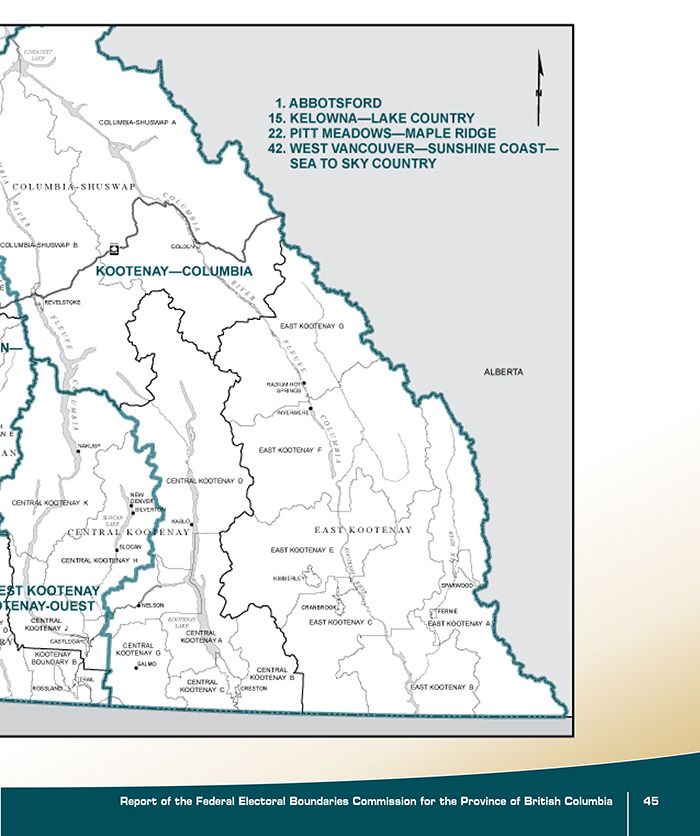Nelson, Salmo and Kaslo could soon join the Kootenay-Columbia federal riding if the recommendations made by the BC Federal Electoral Boundaries Commission pass in the House of Commons.
The Commission tabled its report with the House of Commons on January 28. The report modifies the boundary of the Kootenay-Columbia riding to include Nelson, Salmo, Kaslo and surrounding area, but lops off Nakusp, joining it with the new riding of South Okanagan-West Kootenay.
The Commission is mandated to increase the province’s electoral districts from 36 to 42 because of a population increase to 4,400,057, according to the 2011 census. The electoral quota for British Columbia is 104,763 residents per electoral district.
The proposal is sure to be controversial in the West Kootenay, where local politicians and residents have argued against the move as it would split Nelson from its neighbouring cities of Castlegar and Trail.
Kootenay-Columbia MP David Wilks said he supports the changes, though he expects his BC Southern Interior NDP counterpart Alex Atamanenko to oppose them.
“I expected most of it to happen,” Wilks said. “I’m not opposed to any of it. The commission had a tough job to do. They had to try and get every riding up, and that’s what they had to do.”
He did note that expanding the riding would create additional challenges due to the fact he would have to represent more communities — should he win re-election.
“Having said that, I’ve made a promise all along that if I am re-elected in 2015 – and I do plan to run – that I would have an office in Nelson as well as Cranbrook, and that would assist the riding immensely,” he said.
The result basically chops the existing BC Southern Interior riding in two – adding Nelson, Salmo and Kaslo to Kootenay-Columbia; and re-naming the BC Southern Interior riding as South Okanagan-West Kootenay, which would include Nakusp, Trail, Castlegar, Fruitvale, Grand Forks, Penticton and Osoyoos.
The BC Southern Interior riding has traditionally been NDP, while Kootenay-Columbia and the south Okanagan are traditionally Conservative, meaning the proposed changes could have significant political implications. They add almost 20,000 people from NDP-dominated areas to the Kootenay-Columbia, a riding that the Conservative Party (and the Reform Party before it) has dominated for 20 years.
John Chisamore, the president of the Kootenay-Columbia NDP riding association said the changes should be helpful to his party.
“Is it going to be enough to get us up close to the Conservative numbers?” he said. “I know that when we did look at it, it wasn’t going to be enough but it would give us a better chance.”
Under the new alignment, however, BC Southern Interior NDP MP Atamanenko would lose Nelson — an NDP party stronghold — to the Conservative Kootenay-Columbia riding. Atamanenko is in Russia on a trade mission and unavailable for comment.
This would hurt Atamanenko’s chances for re-election, said political observer Wolf Depner.
Atamanenko, “is going to be in a much tougher spot now. If Nelson falls out of his riding, that’s a good chunk of his vote there,” said Depner, a former journalist who’s now a doctoral candidate in political science at UBC Okanagan.
The new Kootenay-Columbia riding would have a population of 107,589 people, 2.7 per cent above British Columbia’s electoral district quota. According to the commission’s report, they looked at keeping the riding as is, but it would have had a population 16 per cent below the quota without the changes.
“Submissions encouraged the Commission to keep Nelson, Castlegar and Trail in one electoral district,” the report states. “However, such a combination would have resulted in an electoral district with numbers well above the electoral quota.”
The Federal Electoral Boundaries Commission reviews the boundaries of the federal ridings every 10 years. B.C. gained six new ridings this time – one on Vancouver Island and five in the Lower Mainland. The commission is composed of Justice John Hall, Dr. Peter Meekison, Chancellor of Royal Roads University; and Stewart Ladyman, a former school administrator. The new boundaries will be studied this spring by a House of Commons committee that will accept MPs’ written objections, which will then be sent back to the commission for consideration. The final realignment will be submitted to Canada’s Chief Electoral Officer in September.
Alex Cooper
Reporter, The Revelstoke Times Review — a Black Press Publication
reporter@revelstoketimesreview.com
—With files from Nicole Trigg, The Valley Echo
